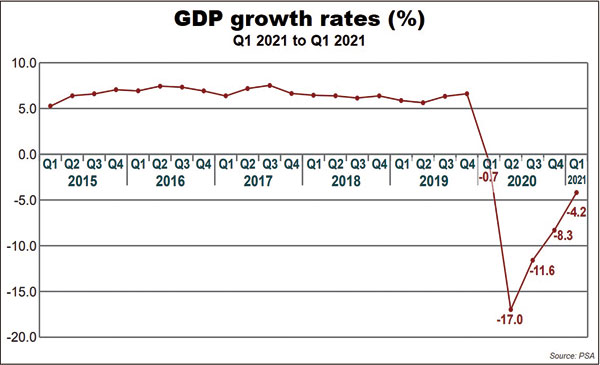The Philippines continues to be in recession as the economy posted its fifth consecutive quarter of decline in the first quarter, with the gross domestic product (GDP) shrinking by 4.2 percent, the Philippine Statistics Authority (PSA) reported yesterday.
Dennis Mapa, national statistician, said in a virtual press briefing prior to this five-quarter year-on-year decline, the longest period with negative GDP was nine consecutive quarters during the Marcos era.

The economy’s contraction in the first quarter represented a sharper drop versus the first quarter of 2020’s 0.7 percent.
The year-on-year performance in the first quarter however was better than the second, third and fourth quarters of 2020 when the economy shrank 17 percent, 11.6 percent and 8.3 percent, respectively.
The PSA said main contributors to the decline were construction, -24.2 percent; other services, -38 percent; and real estate and ownership of dwellings, -13.2 percent.
Among the major economic sectors, agriculture fell by 1.2 percent in the first quarter of 2021.
Services and industry contracted by 4.4 percent and 4.7 percent, respectively during the period.
Mapa said based on data collected from major emerging economies in the region that have released their first quarter 2021 GDP growth, China posted the strongest growth with 18.3 percent, along with Vietnam with 4.5 percent, while Indonesia recorded a contraction of 0.7 percent.
He added private sector analysts expect Malaysia to also contract by 2.6 percent and Thailand by 3.5 percent.
“However, looking at the quarter-on-quarter GDP growth, the Philippines showed a growth of 0.3 percent. On the other hand, Indonesia contracted by 0.96 percent, China and South Korea grew by 1.6 percent, both quarter-on-quarter,” Mapa said.
The Development Budget Coordination Committee has set a growth projection for the year of 6.5 to 7.5 percent.
Karl Kendrick Chua, National Economic and Development Authority secretary, said in the joint statement of the economic managers that he read during the briefing that while the past seven weeks of stricter quarantine restrictions in the National Capital Region (NCR) Plus area will pose downside risks to growth, the country’s actions in the remaining eight months can reverse these initial losses.
“The latest economic performance shows the limit of economic recovery without any major relaxation of our quarantine policy. Thus, once the present spike is over, we can implement quarantine relaxations in a phased approach to boost our recovery this year,” Chua said during the virtual briefing.
“For instance, we can move the NCR towards modified general community quarantine, allow families and their children to participate in the economy, and restart face-to-face schooling,” he added.
Chua said the impact of the implementation of the enhanced community quarantine (ECQ) and the modified enhanced community quarantine (MECQ), due to the recent spikes in COVID-19 cases over the past weeks, on the second quarter growth is expected to be more muted compared to last year, when the country had a stricter version of the ECQ around this time in 2020.
“We will be reviewing first quarter performance to assess on the trajectory of growth for the rest of the year. We have seen some losses in the imposition of ECQ and MECQ, we still have eight full months to recover and to catch up,” Chua said.
Chua added the projection for the 2021 assumes that the arrival of COVID-19 vaccines will begin to ramp up in the middle of the year.
“We are actually on track. We expect some 27 million doses (of COVID-19 vaccines) to come from now until July,” Chua said.
For this quarter, there is a strong reason to see better or even positive growth, he said.
“For those who think that the second quarter will be negative, the only way for that to happen is if the quarantine restriction and economic activity is worse than last year,” Chua said.
“While we are in ECQ and MECQ (the past weeks)… it’s very different. People can work, public transport is open, curfew exempts the workers, and so on. So I don’t think that negative second quarter growth is possible. Of course, there could be other factors,” he added.
“This whole situation right now is very fluid. So we will review the first quarter data and see how that will impact the rest of the year’s growth trajectory. We remain hopeful that as we manage the risk, we open the economy safely, implement the recovery program and accelerate the vaccine, we are still able to achieve the targeted growth rate,” Chua also said.
Meanwhile, Malacanang yesterday expressed confidence the economy would continue to improve as it emphasized the importance of keeping the economy open.
Presidential spokesman Harry Roque said the longer the economy remains closed, the more people would be unable to work and the more people will be hungry which would further affect the country’s economic growth.
Roque said if Filipinos continue to follow the minimum health protocols and more industries are opened, the GDP would to grow and the country may soon graduate from recession by yearend.
“We can expect the GDP to be in the positive level in the next quarters of the year. We can still do it, we still have eight months in 2021),” Roque said. (with J. Montemayor)




